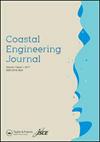台风海燕风暴潮对建筑物的模拟洪水力
IF 1.9
3区 工程技术
Q3 ENGINEERING, CIVIL
引用次数: 2
摘要
2013年的“海燕”是影响菲律宾最强大的台风之一,其所到之处摧毁了莱特岛的大部分地区,并对塔克洛班市的建筑造成了广泛的破坏。为了了解风暴潮对被认为重要的建筑物可能产生的影响,作者使用了一个耦合模型来预测海燕期间发生的洪水。该耦合模式包括:采用Bogussing方案的WRF模式模拟海盐通过过程中的大气条件,采用有限体积海岸海洋模式(FVCOM)模拟风暴潮,得到风暴潮的边界条件(水静力、水动力和破碎波),采用STAAD.Pro软件计算相应的轴向、剪切、以及基于风暴潮模拟的弯矩包络。他们对塔克洛班一所四层的公立学校建筑进行了建模,并分析了风暴潮对一根角柱的影响。结果表明,考虑洪水荷载时,角柱轴向、剪力和弯矩均显著增大,说明在基本结构设计中考虑洪水荷载的重要性。本文章由计算机程序翻译,如有差异,请以英文原文为准。
Simulated flood forces on a building due to the storm surge by Typhoon Haiyan
ABSTRACT Haiyan in 2013 was one of the most powerful typhoons to have affected the Philippines, devastating in its path a wide portion of Leyte, and causing extensive damage to structures in Tacloban City. To understand the likely impacts that would be exerted by a storm surge on a structure deemed important, the authors used a coupled model that hindcasted the flooding that took place during Haiyan. This coupled model included the use of the Weather Research and Forecasting (WRF) Model (with Bogussing scheme) to simulate the atmospheric conditions during the passage of Haiyan, the Finite Volume Coastal Ocean Model (FVCOM) to simulate the storm surge and obtain the boundary conditions for the wind and flood (hydrostatic, hydrodynamic, and breaking wave), and the Structural Analysis and Designing Program (STAAD.Pro) to calculate the corresponding axial, shear, and bending moment envelopes based on the storm surge simulation. A 4-floor public school building in Tacloban was modeled and the effects that the storm surge would have on a corner column were analyzed. Based on the results, the axial, shear, and moment at the corner column significantly increased when considering flood loads, indicating the importance of including such loads in the design of essential structures.
求助全文
通过发布文献求助,成功后即可免费获取论文全文。
去求助
来源期刊

Coastal Engineering Journal
工程技术-工程:大洋
CiteScore
4.60
自引率
8.30%
发文量
0
审稿时长
7.5 months
期刊介绍:
Coastal Engineering Journal is a peer-reviewed medium for the publication of research achievements and engineering practices in the fields of coastal, harbor and offshore engineering. The CEJ editors welcome original papers and comprehensive reviews on waves and currents, sediment motion and morphodynamics, as well as on structures and facilities. Reports on conceptual developments and predictive methods of environmental processes are also published. Topics also include hard and soft technologies related to coastal zone development, shore protection, and prevention or mitigation of coastal disasters. The journal is intended to cover not only fundamental studies on analytical models, numerical computation and laboratory experiments, but also results of field measurements and case studies of real projects.
 求助内容:
求助内容: 应助结果提醒方式:
应助结果提醒方式:


